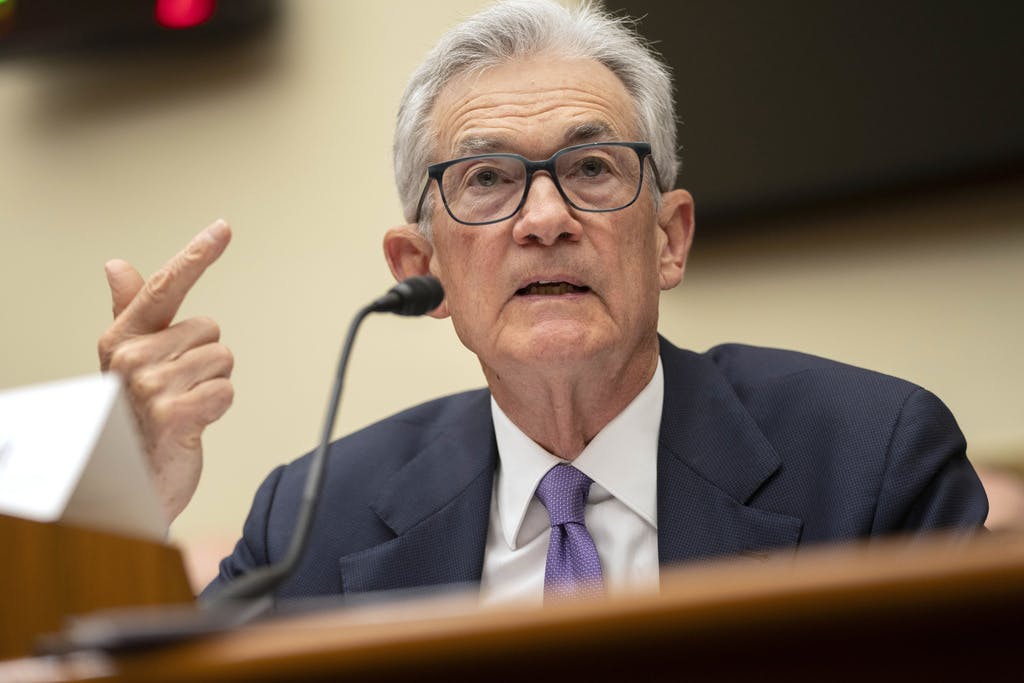What Happens If, Amid an Election, the Fed Cuts Key Interest Rate Only To See Inflation Surge Again?
The question arises because we’re getting hints that the Fed’s 2 percent inflation target doesn’t have to be actually reached before monetary officials ease up on rates.

What if the Federal Reserve proceeds to cut its key interest rate this year — as it clearly aims to do — only to see inflation start to go back up? We are already getting hints that the Fed’s vaunted 2 percent inflation target does not have to be actually reached before monetary officials ease up on rates; just moving toward it will suffice.
The Federal Reserve’s chairman, Jerome Powell, stated on Wednesday that the current policy interest rate is “likely at its peak.” Does that mean Fed policymakers would tolerate a higher inflation rate rather than revert back to lifting interest rates? Such a decision would be welcomed by certain Democrat lawmakers who think the inflation target should be higher.
All of which highlights the need to recognize that the Fed’s definition of price stability is not about delivering sound money — money that retains its value — but rather something different. It is about promoting low and stable inflation through a managed fiat currency. In economic terms, the difference is a matter of specifying the target rate of deteriorating value.
In terms of political philosophy, though, it’s the difference between empowering individuals versus government. How did the Fed’s mandate to ensure “stable prices” transform into a monetary policy to generate 2 percent inflation? What is the economic rationale? Would Congress have publicly approved the idea that targeting 2 percent inflation was consistent with regulating the value of the nation’s money in accordance with constitutional and legislative intent?
The Full Employment and Balanced Growth Act of 1978, better known as the Humphrey-Hawkins Act, established national objectives for government policymakers that included stable prices, maximum employment, and a balanced budget. The legislation specifically called for the reduction of inflation to zero by 1988 provided this goal would not interfere with its 3 percent unemployment objective.
Does that mean the Fed’s inflation target should be zero? “When we talk about price stability as a goal, setting aside the measurement problem, are we talking about price stability or are we talking about zero inflation?” asked Alan Greenspan, then Fed chairman, as he opened discussion on that question among monetary policy committee members in July 1996.
“I think we have a wonderful argument brewing,” Mr. Greenspan observed, according to the meeting transcript.
Janet Yellen, a Fed governor at the time, led off by advocating for a 2 percent inflation rate — but no lower. Citing what she referred to as “the greasing-the-wheels argument” prevalent in Keynesian economics, Ms. Yellen suggested “a little inflation lowers unemployment by facilitating adjustments in relative pay in a world where individuals deeply dislike nominal pay cuts.”
Since employees resist pay cuts even when firms are experiencing losses, according to the greasy wheels theory, inflation provides cover for achieving real wage cuts without imposing the blow of reducing nominal pay. “We are dealing here with a very deep-rooted property of the human psyche,” Governor Yellen observed.
To further the point, Ms. Yellen referenced a survey asking a random sample of Americans whether they agreed with the statement: “I think that if my pay went up, I would feel more satisfaction in my job, more sense of fulfillment, even if prices went up just as much.” She reported that 28 percent of the respondents fully agreed, and another 21 percent partially agreed; only 27 percent completely disagreed with the statement.
Ms. Yellen added: “I think it will comfort you to learn that in a special subsample of economists, not one single economist fully agreed, and 78 percent completely disagreed.” The transcript notes parenthetically that laughter ensued.
The president of the Federal Reserve Bank of Cleveland, Jerry Jordan, challenged the argument that money illusion leads to better economic outcomes. “In my view, businesses and households make their best decisions about the future, whether personal investment decisions or business decisions, when they expect the purchasing power of the dollar to be the same in the future as it is today.”
Mr. Jordan suggested that a more useful survey would ask people whether the purchasing power of the dollar should be deliberately diminished by 2 percent inflation versus 3 percent inflation over the next 100 years — reducing its purchasing power down to 13.8 cents versus 5.2 cents. “I think most people would view that as a silly alternative. They would say, why not zero inflation.” Changing the standard of value over time, Mr. Jordan contended, neither improves resource allocation nor raises the standard of living.
The Fed vice chairman, William J. McDonough, now sadly gone, thought price stability had “major sociological and therefore political benefits” and that formalizing a numerical definition for achieving it was “something of such great importance to our society that it should be the American people who decide that through the normal legislative processes.”
McDonough believed the monetary policy committee should not take a position. “I say that because if we said price stability is 2 percent — if we were ever able to agree on that — we might set the Federal Reserve against the people.”
It would be more than 15 years later before the Fed would officially adopt a 2 percent inflation target. That was in January 2012 under Chairman Ben Bernanke. As justification, Mr. Bernanke noted that a zero inflation rate would mean nominal interest rates at very low levels, which would give the Fed less room to cut interest rates to boost employment during an economic downturn.
When asked whether the Fed might be criticized for deliberately seeking a 2 percent decline in the dollar every year, Mr. Bernanke dismissed the argument as weak — “unless you’re one of those people who does their lifetime saving in the mattress.” It seems such persons are the monetary policy version of Hillary Clinton’s “basket of deplorables.”
Upholding the nation’s monetary standard deserves more respect. The power granted to Congress in Article I, Section 8, of the Constitution — to coin money and regulate the value thereof — is, after all, given in the same sentence that grants Congress the power to fix the standard of weights and measures.
As Thomas Jefferson wrote in 1784: “If we determine that a dollar shall be our unit, we must then say with precision what a dollar is.” He believed America’s money should provide a dependable and constant standard of value — worthy of a self-governing people.

